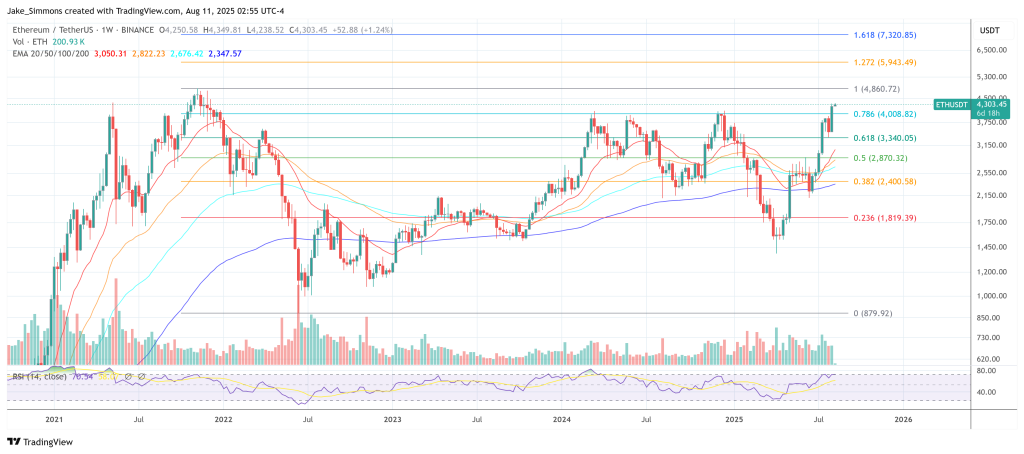11 August 2025
In an August 10 video titled “My End Of 2025 ETH Price Prediction (Using AI) — You’re Not Bullish Enough!”, crypto analyst Miles Deutscher said Ethereum’s latest breakout above the “very key level in the $4,000 zone” has shifted the market into what he views as a confirmed, structurally stronger advance toward new all-time highs. “We actually did get a daily close,” he noted, adding that the weekly close above the same region—something Ethereum “hasn’t closed above on the weekly since November 2021”— underscores the significance of the move. In Deutscher’s framework, that close is “confirmation for a much bigger run.”
How High Can Ethereum Go?
Deutscher centered the analysis on a simple question—how high can Ethereum go—and answered it with a blend of technical context and model-driven probabilities. Before invoking AI, he sketched an “eye test” path in which price discovery unfolds “well into this range here between $6,000 to $8,000,” arguing that Ethereum is effectively “playing catch-up” after lagging other top assets that already printed new highs.
He even floated a directional benchmark—“I think the price prediction is going to be $7,000”—before deferring to probability distributions as a more disciplined way to size the upside. To that end, he ran two large-language models on a shared set of inputs, asking for odds of specific price bands by the end of 2025 and then by the end of 2026.
On his telling, the first model’s 2025 peak probabilities favored continuation: roughly a three-in-four chance to revisit the prior high near $4.7k, about sixty-plus percent to clear $5k, around thirty percent to reach $6k, high-single-digits to breach $7.5k, and roughly one percent to tag $10k this year.
Expanding the window through 2026 raised those odds materially, to what he summarized as high confidence in $4.7k–$5k, better-than-even odds for $6k, and about forty percent for $7.5k, with a non-trivial tail—“even here 10k plus it’s giving an 18% probability to.”
Running the same exercise on Grok produced a more aggressive contour. As Deutscher relayed it, Grok’s “base case could very well be $10,000,” with an $8,000–$15,000 band as a plausible cycle-top range.
He quoted the model’s technical guardrails explicitly: “A break above $4,800 signals new all-time high pursuit. Drop below $3,800 could invalidate the bullish thesis.” By contrast, his own trading invalidation skews tighter to trend, cautioning that “if Ethereum drops below the money noodle on the daily, which right now is around like $3,400, I think structurally this could start to invalidate the bullish move at least in the short term,” while “as long as we maintain above $4,000, we are in the pursuit of that prior all-time high.”
Headwinds For Ether
The projection stack rests on a macro-to-micro chain of tailwinds that Deutscher argued now favors Ethereum more directly than in prior cycles. He cited consistently positive ETF flows—“around $17 billion of net inflows into the crypto ETFs over the last 60 days, $11 billion coming in the month of July alone,” with particular traction on the ether side—alongside anticipated retirement-account access to crypto that could unlock what he called a “massive pool of new buyers.”
He framed recent US policy steps as a near-term accelerant for on-chain finance, saying the GENIUS Act clarified treatment for a set of crypto assets and “regulates some of the key stable coins,” thereby widening the aperture for institutional yield strategies and tokenization. In his view, those are specifically Ethereum-centric growth funnels because “Ethereum is the biggest blockchain facilitating asset tokenization and DeFi,” which makes ETH “the number one proxy for anyone looking to get exposure to this narrative.”
Deutscher also paired the flows argument with market-structure observations: stablecoins at fresh highs, price resilience marked by “sell-offs… relatively short-lived,” and a turn in bitcoin dominance that, if it persists, historically precedes broader alt rotation with ETH at the fulcrum.
None of this, he stressed, implies a straight line. Deutscher expects the cycle to oscillate through rotations—bitcoin strength, an ether catch-up, then a higher-beta alt expansion—rather than a single monolithic “altseason.”
He even penciled in a likely second-leg window into 2026, aligning with political and monetary calendar points, while cautioning that “you never know what’s going to happen” and emphasizing the need for clear invalidations.
Still, the directional conclusion is unambiguous: the combination of structural inflows, regulatory clarity around on-chain finance, and Ethereum’s technical regime shift leaves him biasing to the upside. “This would be hard momentum to slow down in the short to mid-term,” he said, adding that the true “FOMO” phase probably begins only once ETH is in price discovery above its $4,800 peak.
At press time, ETH traded at $4,303.
